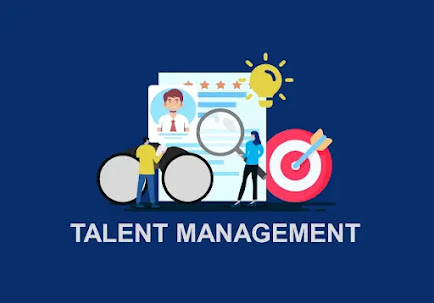Talent Management
Image Source: https://slidebazaar.com/blog/wp-content/uploads/2020/09/Talent-Management-Featured-Image.jpga access on 4th 12 2022
Introduction
According to Armstrong (2014)
"The term ‘talent management’ may refer simply to management succession
planning and/or management development activities, although this notion does
not really add anything to these familiar processes except a new name –
admittedly quite an evocative one. It is better to regard talent management as
a more comprehensive and integrated bundle of activities, the aim of which is
to create a pool of talent in an organization, bearing in mind that talent is a
major corporate resource”.
According to Lewis and Hackman
(2006), talent management is defined in three ways
1) as a combination of standard
human resource management practices such as recruitment, selection, and career
development
2) as the creation of a large talent pool,
ensuring the quantitative and qualitative flow of employees through the
organization (i.e. akin to succession or human resource planning)
(3) as a good based on the demographic necessity to manage talent. (Armstrong,2014, p. 264)
Talent management seeks to
attract, identify, develop, engage, retain and deploy individuals who are
considered particularly valuable to an organization. To be effective, it needs
to align with strategic business objectives. By managing talent strategically, organizations
can build a high-performance workplace, foster a learning climate, add value to
their employer brand, and improve diversity management. (CIPD,2022)
What is talent?
According to Armstrong (2014) “Talent
was defined by Michaels et al (2001, xii) as ‘the sum of a person’s
abilities... his or her intrinsic gifts, skills, knowledge, experience,
intelligence, judgment, attitude, character, and drive. It also includes his
or her ability to learn and grow.’ Talent is what people must have in order to
perform well in their roles. They make a difference in organizational
performance through their immediate efforts, and they have the potential to
make an important contribution in the future. Talent management aims to identify,
obtain, keep, and develop those talented people”.
According to the (ADP) Impact of Talent Management
Businesses that
take the time to develop their employees and keep them engaged tend to be
innovative and profitable. Conversely, those that are unable to source or
retain talent generally have poor customer satisfaction and limited growth
potential.
Equipping
and engaging talent to optimize productivity and fuel growth is not a singular
task. There are numerous employer responsibilities, such as the following,
which must be fulfilled to excel at talent management:
- Workforce planning
Most talent strategies begin with defining the skillsets that will be required to achieve the business’s objectives. - Recruitment
Acquiring talent consists of representing the employer brand effectively, determining where the right candidates can be reached, prescreening applicants, and interviewing promising prospects. - Onboarding
A structured onboarding program that introduces employees to the workplace culture and helps them feel connected to and comfortable with their team and organization is essential to retention. - Training and development
While it was once considered the employee’s responsibility to seek learning opportunities, many workers today expect their employers to provide the tools, guidance, and support they need to further their careers. - Performance management
Reviews and check-ins with team leaders help employees build upon their strengths, thereby increasing engagement and reducing turnover, and making it possible for employers to meet key business objectives. - Compensation and benefits
Fair compensation is important, but employers who want to attract and retain talent should take a holistic view of the perks and benefits they offer beyond a paycheck. - Succession planning
Preparing for the next step in the employee journey – whether it’s career advancement, retirement or resignation – can help people transition to new roles quickly and limit disruptions
Reference:
Armstrong, M. and Taylor, S.
(2014) Armstrong’s Handbook of Human Resource Management Practice.
13th ed. London: Kogan Page publishers.
[Online] CIPD(2022)
Talent management [Available From] https://www.cipd.co.uk/knowledge/strategy/resourcing/talent-factsheet#gref [Accessed on 03.12.2022]
[Online] ADP what-is-talent-management.
[Available From] https://www.adp.com/resources/articles-and-insights/articles/w/what-is-talent-management.aspx
[Accessed on 03.12.2022]


.jpg)

Yes, agree with you, if you really recognize, analyze and identify employees' talent you can achieve company objectives very easily.
ReplyDelete